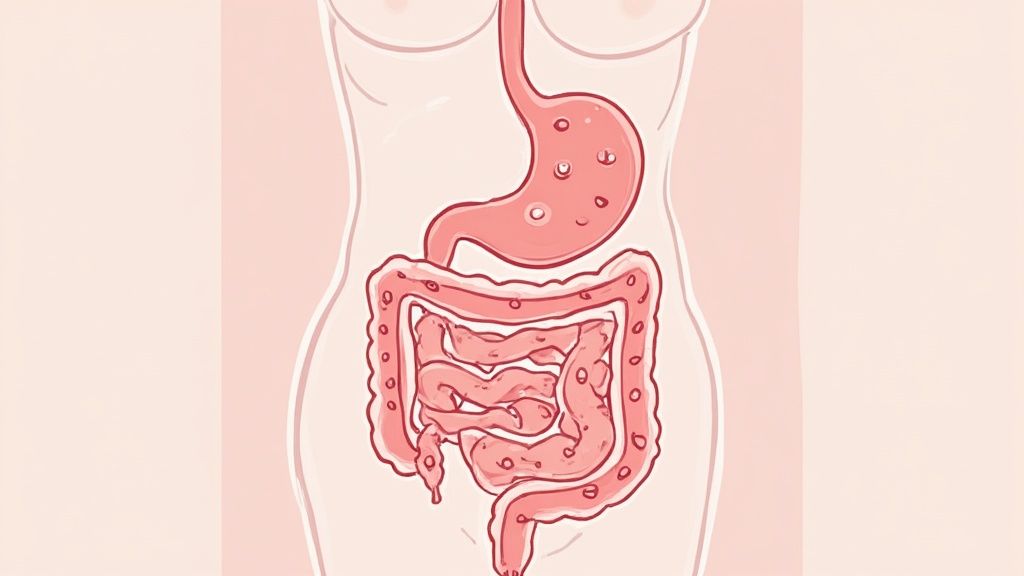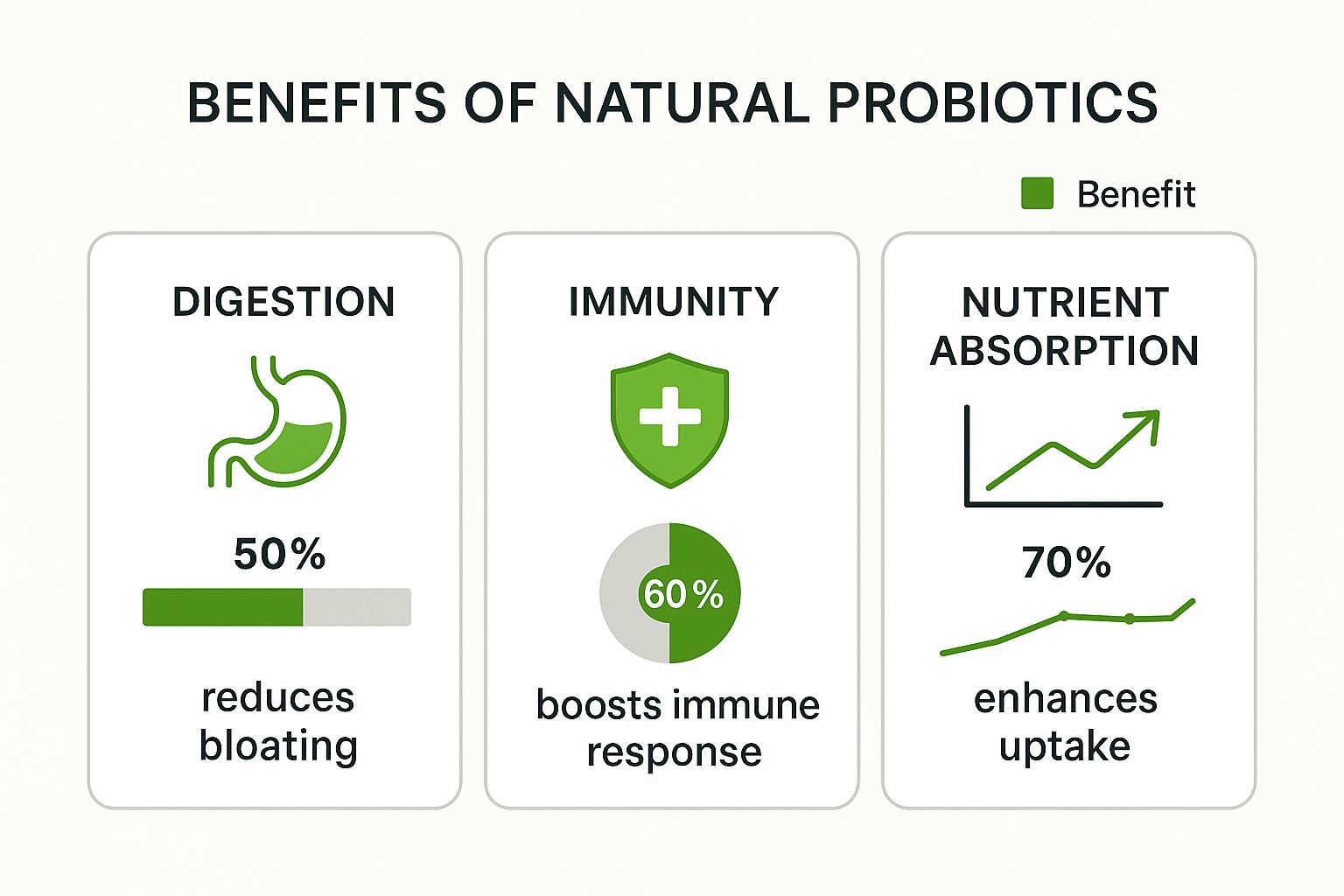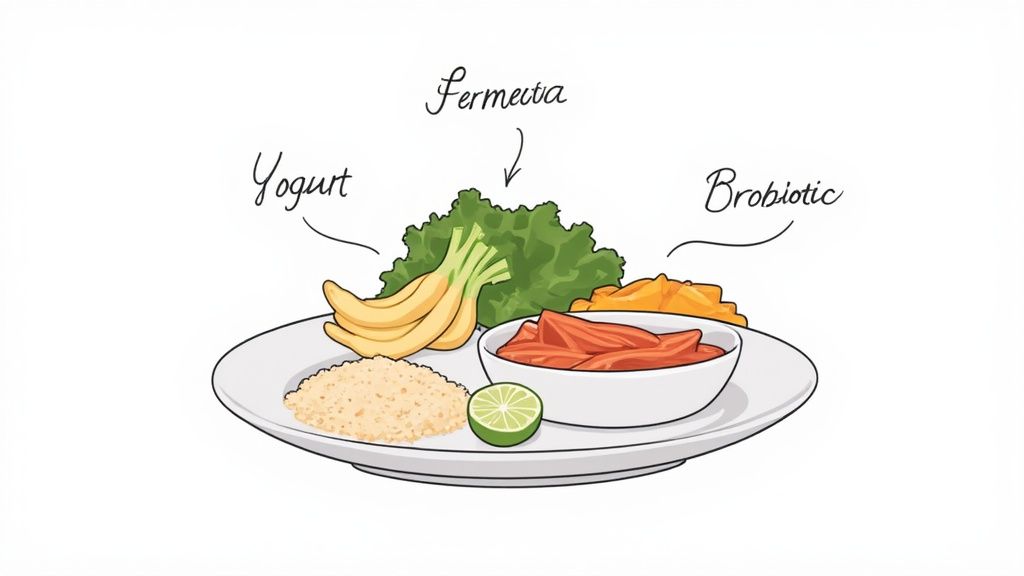Your Complete Guide to Natural Probiotics for Optimal Health
Understanding Your Body's Microscopic Allies
 Imagine your gut as a bustling city thriving inside you. This city is home to trillions of microscopic residents, mostly bacteria, which together form what we call your gut microbiome. Just like any well-run metropolis, this internal ecosystem has various microorganisms performing specialised jobs to keep everything operating smoothly. Natural probiotics are the friendly, helpful citizens in this community. They are live microorganisms that, when you consume enough of them, provide a real health benefit. They aren't just bystanders; they are active peacekeepers and skilled workers helping to maintain order.
Imagine your gut as a bustling city thriving inside you. This city is home to trillions of microscopic residents, mostly bacteria, which together form what we call your gut microbiome. Just like any well-run metropolis, this internal ecosystem has various microorganisms performing specialised jobs to keep everything operating smoothly. Natural probiotics are the friendly, helpful citizens in this community. They are live microorganisms that, when you consume enough of them, provide a real health benefit. They aren't just bystanders; they are active peacekeepers and skilled workers helping to maintain order.
The Role of Probiotics in Gut Harmony
These tiny allies play several key roles in supporting your overall wellbeing. One of their main jobs is to maintain a healthy balance among the residents of your gut city. They compete with potentially harmful bacteria for space and food, essentially crowding out the troublemakers and stopping them from taking over. This process, known as competitive exclusion, is vital for digestive health. In short, the good guys make sure the bad guys don't get out of hand.
Natural probiotics also interact with your body’s systems in some amazing ways. They help strengthen the gut barrier—the physical lining of your intestines—making it less likely for toxins and undigested food particles to leak through. A strong barrier is essential for a well-functioning immune system, especially since about 70% of your immune cells are found in your gut.
The Gut-Brain Connection
Perhaps the most fascinating aspect is how this internal city communicates with your brain. This ongoing conversation, called the gut-brain axis, influences everything from your mood and stress levels to your thinking and memory. Probiotics can produce neurotransmitters like serotonin and GABA, which are chemicals that help regulate your mood. This is why a healthy gut is so often connected to a healthier mind, earning the microbiome the nickname "the second brain".
This connection is gaining more and more attention. In New Zealand, for instance, consumer spending on probiotics reached around US$4.3 million back in the mid-to-late 2000s, showing an early awareness of their importance. You can learn more about what Kiwi consumers think about probiotic therapy in this detailed survey from the NZMJ. By feeding this internal ecosystem with natural probiotics, you're not just supporting your digestion but your overall physical and mental health too.
The Science Behind Natural Probiotics That Actually Works

The science behind natural probiotics reveals a world far more complex than just settling an upset stomach. These microscopic allies act like skilled conductors for your body’s internal processes. Their main stage is the gut, where they interact directly with your immune system, helping it to distinguish between real dangers and harmless visitors. This communication can help manage unnecessary inflammation, a key contributor to many long-term health concerns.
This influence doesn't stop at the gut wall. Through a remarkable connection known as the gut-brain axis, specific probiotic strains can produce neurotransmitters like serotonin and GABA. These are the very same chemicals that help regulate our mood and stress levels. For instance, research indicates that strains like Bifidobacterium longum may help soothe feelings of anxiety by sending signals along this vital pathway. These are not quick fixes, but powerful biological partners that support your body’s natural systems.
Specific Strains, Specific Jobs
Think of your gut microbiome as a sports team. To win, you need players with a range of different skills. The world of probiotics is similar, featuring distinct strains, each with a specialised job. A varied diet rich in different natural probiotics gives your body a more versatile team to call upon. Some strains are champions at producing enzymes to break down tricky foods, while others are experts at strengthening the gut lining or fine-tuning immune responses.
For example, Lactobacillus acidophilus is well-known for producing lactase, the enzyme that helps digest lactose found in dairy. This is a big reason why many people who find milk difficult to digest can often enjoy fermented dairy products like kefir or yoghurt without issue. In contrast, Saccharomyces boulardii, a beneficial type of yeast, is frequently recognised for its ability to help restore gut balance after it's been disrupted, such as by a course of antibiotics.
The key takeaway is that different strains offer different benefits, and a flourishing gut thrives on this variety. To help you understand these differences, the table below outlines some of the most common probiotic strains and their primary roles.
Common Probiotic Strains and Their Primary Health Benefits
A comparison of the most researched natural probiotic strains and their specific health applications
| Probiotic Strain | Primary Benefits | Natural Food Sources | Research Level |
|---|---|---|---|
| Lactobacillus acidophilus | Supports lactose digestion and vaginal health. | Yoghurt, Kefir, Miso | High |
| Bifidobacterium longum | May help reduce anxiety and supports the gut barrier. | Kefir, Kimchi, Sauerkraut | Moderate to High |
| Saccharomyces boulardii | Helps restore gut flora, especially after antibiotics. | Kombucha, Water Kefir | High |
| Lactobacillus casei | Supports the immune system and may improve constipation. | Fermented Cheeses, Yoghurt | Moderate to High |
As you can see, each strain brings something unique to the table. From supporting digestion to influencing mood, the right combination of probiotics can play a significant role in your overall well-being. Focusing on a diet that includes a variety of fermented foods is an excellent way to introduce these different players to your internal team.
Real Food Sources vs Supplement Strategies
Deciding whether to get your probiotics from food or a bottle can feel like choosing between a home-cooked meal and a carefully prescribed vitamin. Both can nourish you, but they work in different ways and suit different needs. The best path for you often comes down to your health goals, lifestyle, and what you want to achieve for your gut.
The Power of Fermented Foods
When you eat natural probiotics from whole foods like yoghurt, kimchi, sauerkraut, or kefir, you get much more than just a dose of live bacteria. These foods offer a complete nutritional package. Think of it like planting a garden: the probiotics are the seeds, but the food itself provides the fertile soil (fibre and prebiotics), water (nutrients), and sunlight (enzymes). This built-in support system helps the good bacteria establish themselves and flourish in your gut.
Naturally fermented foods deliver a diverse community of beneficial microbes, not just one or two isolated strains. This variety is crucial for building a resilient and balanced microbiome. For instance, a single serving of traditional sauerkraut can contain a wide array of Lactobacillus species, each with a unique role to play on your gut’s internal team. This approach is often ideal for general wellness and maintaining a healthy digestive system.
The infographic below shows some of the core benefits you can expect from a healthy gut supported by natural probiotics.

As you can see, a balanced microbiome directly supports digestion, strengthens immunity, and improves how well you absorb nutrients from your food.
When Supplements Make Sense
While a food-first approach is a great foundation, probiotic supplements have their own important role. Think of them as calling in a specialist for a specific job. If you’re dealing with a particular health issue, like recovering after a course of antibiotics or managing IBS symptoms, a supplement can provide a concentrated, high-potency dose of specific strains known to help. Achieving this level of targeted support through food alone is very difficult.
The convenience of supplements is also a major plus, particularly for those with busy schedules or dietary restrictions that make eating fermented foods challenging. This convenience has fuelled a significant market; the New Zealand probiotic supplement market is projected to grow steadily, in line with a global trend of about 8% yearly expansion. This growth reflects a greater awareness of their targeted benefits. You can find out more about these market trends in this analysis by Acuitas Health Analytics.
To help you weigh the options, the table below offers a side-by-side comparison of probiotic foods and supplements.
| Factor | Natural Foods | Supplements | Best Choice For |
|---|---|---|---|
| Microbial Diversity | High; contains a wide variety of naturally occurring bacterial strains and yeasts. | Lower; typically contains 1 to 15 specific, well-researched strains. | Foods for building a resilient, diverse microbiome for general wellness. |
| Potency | Lower and variable; colony-forming units (CFUs) are not standardised. | High and consistent; CFU count is guaranteed and often very concentrated. | Supplements for delivering a targeted, high-dose therapeutic effect. |
| Nutritional Value | Excellent; provides vitamins, minerals, fibre (prebiotics), and enzymes alongside probiotics. | Minimal; primarily focused on delivering live bacteria, with few other nutrients. | Foods for a holistic nutritional boost that supports overall health. |
| Convenience | Requires preparation, storage (refrigeration), and can have a strong flavour. | Very convenient; easy to travel with, no preparation needed, and flavourless. | Supplements for busy lifestyles, travel, or picky eaters. |
| Targeted Action | General support; benefits are broad and support overall gut balance. | Specific support; strains are chosen to address particular health issues (e.g., IBS, immunity). | Supplements for managing specific symptoms or health conditions. |
| Cost | Can be cost-effective, especially if you make your own (e.g., homemade yoghurt). | Can be more expensive, with costs varying by brand, potency, and strain complexity. | Foods for budget-conscious individuals focused on maintenance. |
Ultimately, the best strategy often involves a combination of both. A diet rich in diverse fermented foods provides a solid foundation for gut health, while a quality supplement can offer a targeted boost when you need it most. For those considering this route, you might find our guide on how to choose gut health supplements helpful for making an informed decision.
Choosing Natural Probiotics That Match Your Needs
 Diving into the world of natural probiotics can feel like a lot to take in, with a huge range of products all making bold claims. But not all probiotics are the same, and the best one for you is entirely dependent on your personal health goals and current situation. To make a smart choice, you need to look beyond the marketing and learn to read the label like a pro.
Diving into the world of natural probiotics can feel like a lot to take in, with a huge range of products all making bold claims. But not all probiotics are the same, and the best one for you is entirely dependent on your personal health goals and current situation. To make a smart choice, you need to look beyond the marketing and learn to read the label like a pro.
Decoding the Probiotic Label
To find a high-quality probiotic, there are a few key details to look for on the packaging. The first is the CFU count, which stands for Colony-Forming Units. Think of this number as the total count of live, active microorganisms you get in each dose. While bigger isn't always better, a reputable product will guarantee its CFU count right through to its expiry date, which means the bacteria are still alive and effective when you consume them. For general health maintenance, a product with 1 to 10 billion CFUs is usually a solid starting point.
Next, have a look at the strain diversity. A supplement containing multiple, well-researched strains from different families, such as Lactobacillus and Bifidobacterium, often provides a broader spectrum of benefits than a single-strain formula. This is because different strains act like different specialists, each performing unique jobs within your gut.
Aligning Probiotics with Your Health Goals
The ideal probiotic for you is one that is tailored to your specific needs. Are you aiming for general immune support and digestive upkeep, or are you trying to manage a particular health concern?
- For Daily Wellness: A broad-spectrum probiotic with a mix of strains is a great pick for everyday gut health and immune system support. A simple, daily routine helps to keep your gut microbiome in a healthy state of balance. For this kind of maintenance, a product like Rawbiotics Daily Balance can provide a reliable foundation.
- After Antibiotics: Antibiotics, particularly broad-spectrum types, can seriously disrupt your gut microbiome by eliminating both good and bad bacteria. Interestingly, some newer research indicates that taking probiotic supplements straight after a course of antibiotics might actually slow down the natural recovery of your gut bacteria. It's often suggested to start with probiotic-rich foods to gently re-establish beneficial colonies.
- For Specific Digestive Issues: If you're struggling with problems like bloating or symptoms of IBS, you may find relief from specific, clinically studied strains known to address those issues. Search for products that clearly list the exact strains used—not just the species—and have research backing their effectiveness for your symptoms.
Ultimately, selecting the right natural probiotics comes down to personalisation. By understanding your own health objectives and learning what to spot on a label, you can choose a product that offers real, targeted support for your wellbeing.
Making Natural Probiotics Part of Daily Life
Adding **natural probiotics** to your routine doesn't mean you need a total lifestyle overhaul. It’s more like introducing a new, flavourful ingredient to your kitchen. The secret is to start small and keep it enjoyable, turning gut health from a chore into a simple, delicious habit. A great way to begin is by weaving probiotic-rich foods into the meals you already know and love, which makes building consistency feel natural.
By focusing on simple swaps and tasty additions, you can easily turn your kitchen into a hub for gut-friendly foods. For those with a packed schedule, these small adjustments can make a real difference without adding any stress.
Simple Meal Planning Strategies
Making natural probiotics a daily habit is all about smart, simple planning—no complex recipes needed, just thoughtful additions. A fantastic place to start is breakfast, as it sets the tone for your entire day.
- Morning Kick-start: Try swapping your usual milk for kefir in a morning smoothie or with your cereal. A spoonful of live-culture yoghurt on top of your oats adds a creamy texture and a welcome dose of beneficial bacteria.
- Lunchtime Boost: Give a simple salad or sandwich a lift with a side of sauerkraut or kimchi. These fermented vegetables bring a tangy crunch that pairs well with many savoury dishes. You can also mix a bit of miso into your salad dressing for a rich, umami flavour.
- Dinner Enhancements: Serve a small helping of pickled vegetables alongside your main course. A glass of kombucha can also be a refreshing, low-sugar substitute for a fizzy drink with dinner.
Time-Saving Tips for Busy People
Maintaining a diet rich in probiotics doesn’t have to take up a lot of time. With a little bit of forward-thinking, you can make sure you always have healthy options ready to go.
- Batch Preparation: Set aside an hour on the weekend to prepare a big jar of homemade sauerkraut or a few servings of overnight oats with yoghurt. This gives you grab-and-go options for several days.
- Smart Storage: Keep your fermented foods like kefir and kimchi in airtight containers in the fridge. This helps maintain their potency and flavour. When stored correctly, most will last for weeks, if not months.
- Combine for Diversity: Don't just stick to one probiotic source. Aim to mix different types throughout the week. For instance, you could have yoghurt on Monday, kimchi with your lunch on Tuesday, and kefir in your smoothie on Wednesday. This variety helps support a more resilient gut microbiome by introducing a broader range of beneficial bacteria.
Timing and Dosage Strategies That Actually Work
To get the most from your natural probiotics, it’s not just about what you take, but also when and how. Imagine these good bacteria as tiny travellers on a mission to reach your gut. Their journey is a challenging one, as they must first pass through the highly acidic environment of your stomach. Timing your intake correctly can give them a much better chance of arriving safely and getting to work.
The Great Food Debate: With or Without a Meal?
There's been a long-running discussion about whether it's best to take probiotics on an empty stomach or with food. Current thinking suggests that taking probiotics just before or during a meal that contains some fat is the ideal strategy. Food acts as a buffer, shielding the probiotics from the harsh stomach acid and creating a safer passage. The fat in the meal adds an extra layer of protection, helping more of the beneficial bacteria survive the trip to your intestines.
However, the most important factor is consistency. Creating a daily habit is more beneficial than stressing about perfect timing every single time. If taking your probiotic with breakfast is what works for your schedule, then that's the best time for you. The key is to establish a routine that allows these beneficial bacteria to steadily build up in your gut.
Listen to Your Body: Dosage and Adjustments
When you start with any new probiotic, whether it's from a food source or a supplement, it’s always a good idea to start slowly. Think of it like introducing new members to a team; you want to give the existing community time to get used to the newcomers.
- Start Low, Go Slow: Begin with a smaller serving than what's recommended on the package. This approach helps minimise the risk of any temporary digestive issues, like gas or bloating, while your microbiome adjusts to the change.
- Increase Gradually: If you feel fine after a week, you can slowly increase the amount until you reach the full recommended serving. This gentle method allows your gut to adapt comfortably.
- Recognise Positive Signs: Keep an eye out for subtle improvements. These won't likely be dramatic overnight transformations. Instead, you might notice things like more regular bowel movements, feeling less bloated after eating, or just a general sense of better wellbeing.
Ultimately, the best approach is one that fits your lifestyle and feels right for your body. By applying these simple timing and dosage principles, you can help your chosen natural probiotics work effectively to support your overall health.
Separating Natural Probiotics Facts from Fiction
In the world of wellness, natural probiotics are often talked about as a miracle solution for all sorts of health issues. This can create a lot of mixed messages and confusion. It's time to look past the marketing noise and focus on what the science actually tells us. By separating the common myths from the evidence-based facts, you can develop a clearer picture and make better choices for your gut health.
Myth: More Billions of CFUs Are Always Better
One of the most common myths is that a higher CFU (Colony-Forming Unit) count automatically means a superior product. While a big number looks great on the packaging, it isn't the most important measure of quality. Think of it like this: a massive, disorganised crowd isn't nearly as effective as a smaller, skilled team working in unison.
What really counts is strain synergy and viability. This means having the right types of bacteria that are alive, active, and can work together when they reach your gut. A product with 10 billion CFUs from a diverse mix of proven, resilient strains is often more effective than one with 50 billion CFUs from a single, less stable strain. The aim is to create balance, not just to overwhelm your system with numbers.
Fact: Stomach Acid Is a Major Hurdle
A very real concern is whether probiotics can actually survive the harsh, acidic environment of the stomach to do their job in the intestines. This is a significant challenge, and not all probiotic products are up to the task. Some bacterial strains are naturally more resistant to acid than others.
The way a probiotic is delivered also makes a big difference. Live, non-freeze-dried liquid formulas and probiotics taken with food (especially meals with some fat) tend to have a much better survival rate.
Getting past the stomach is the main obstacle, which makes survival a key indicator of a probiotic's quality.
Myth: Probiotics Permanently Change Your Gut
Another popular belief is that taking probiotics will permanently colonise your gut with new, healthy bacteria. The reality is that most probiotics act more like helpful visitors than permanent residents. They travel through your digestive system, providing benefits along the way by supporting your immune system, interacting with your existing microbiome, and helping to manage harmful bacteria.
Their positive effects generally last as long as you continue to take them. Lasting results depend on making key changes to what caused the imbalance in the first place and and helping the gut to restore the microbiome to optimal operation. This is why consistency is so important if you want to see long-term benefits. To learn more about creating a healthy gut environment, feel free to explore other articles on our blog.
Achieve lasting gut harmony with a probiotic you can trust. Discover the benefits of Rawbiotics' live, liquid formula and see what a balanced microbiome can do for you.